| dc.contributor.author | Belyakov, A. V. | en |
| dc.contributor.author | Sarantsev, V. V. | en |
| dc.contributor.author | Gorbachev, A. N. | en |
| dc.contributor.author | Panteleenko, F. I. | en |
| dc.contributor.author | Azarenko, E. L. | en |
| dc.contributor.author | Reutov, B. F. | en |
| dc.coverage.spatial | United States | en |
| dc.date.accessioned | 2022-07-29T08:49:26Z | |
| dc.date.available | 2022-07-29T08:49:26Z | |
| dc.date.issued | 2016 | |
| dc.identifier.citation | Electric-spark alloying technology for improving the working life of steam turbine rotor blades and equipment for its implementation / A. V. Belyakov [et al.] // Power technology and engineering. – 2016. – Vol. 50, № 1. – P. 71-74. | en |
| dc.identifier.uri | https://rep.bntu.by/handle/data/115099 | |
| dc.description.abstract | Work is devoted to studying development of technology for forming erosion-resistant coatings for steam turbine rotor blades by electric-spark alloying. Comparative analysis is provided for current methods of steam turbine rotor blade strengthening and repair. It is shown that electric-spark coating formation on leading edges is important, and development of forming technology is connected with a search for new materials. New engineering solutions are found for coating formation from cobalt stellites, the properties of cobalt stellite and cermet hard alloy VK8 electric-spark coatings are studied, and the effect of operating unit parameters on coating formation is demonstrated. New vibrator structures are created for forming electric-spark coatings making it possible to expand the range of electrode vibration to 260 Hz, and specimens are prepared for testing with coating formation. | en |
| dc.language.iso | en | en |
| dc.publisher | American Society of Civil Engineers | en |
| dc.title | Electric-spark alloying technology for improving the working life of steam turbine rotor blades and equipment for its implementation | en |
| dc.type | Article | en |

